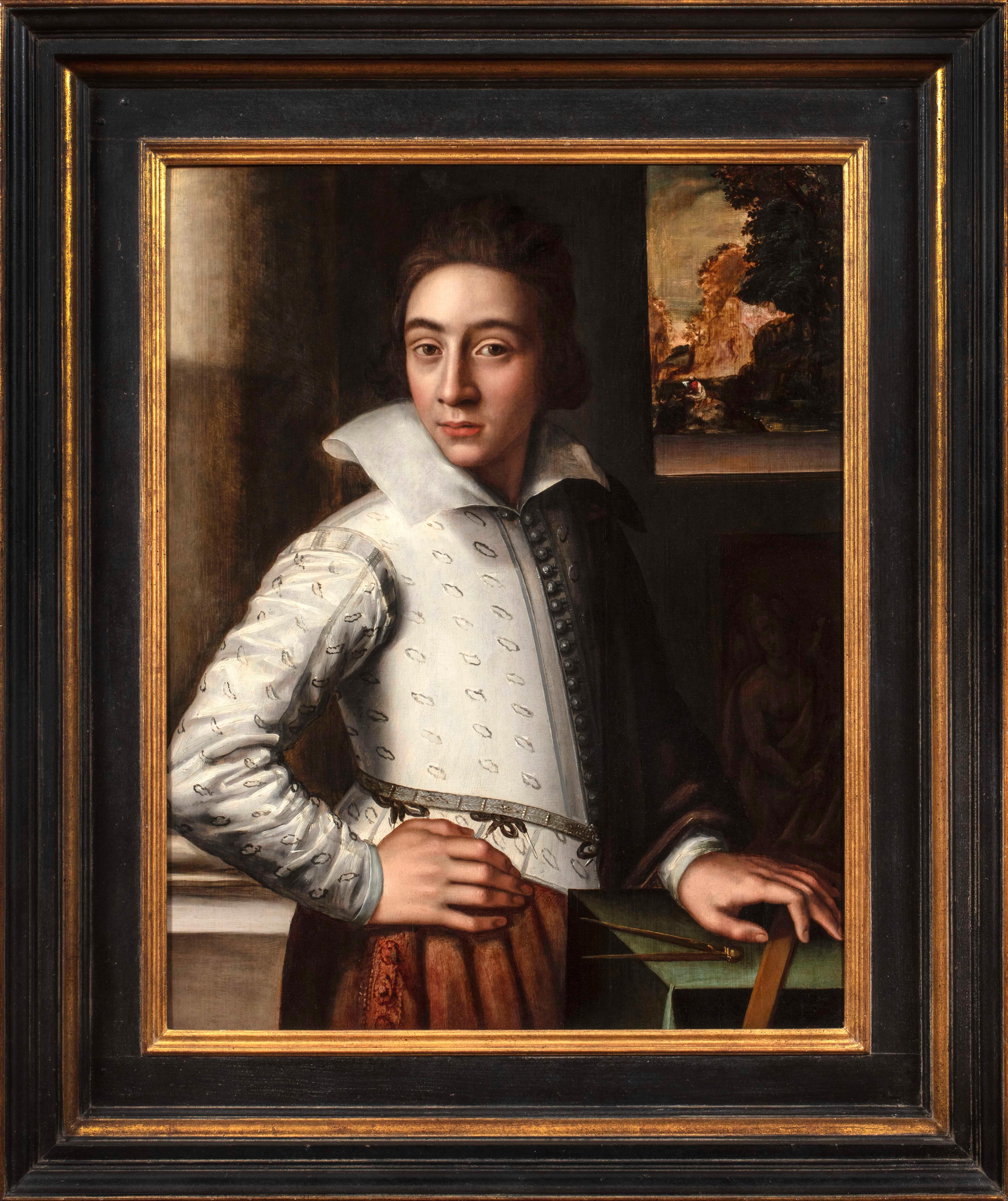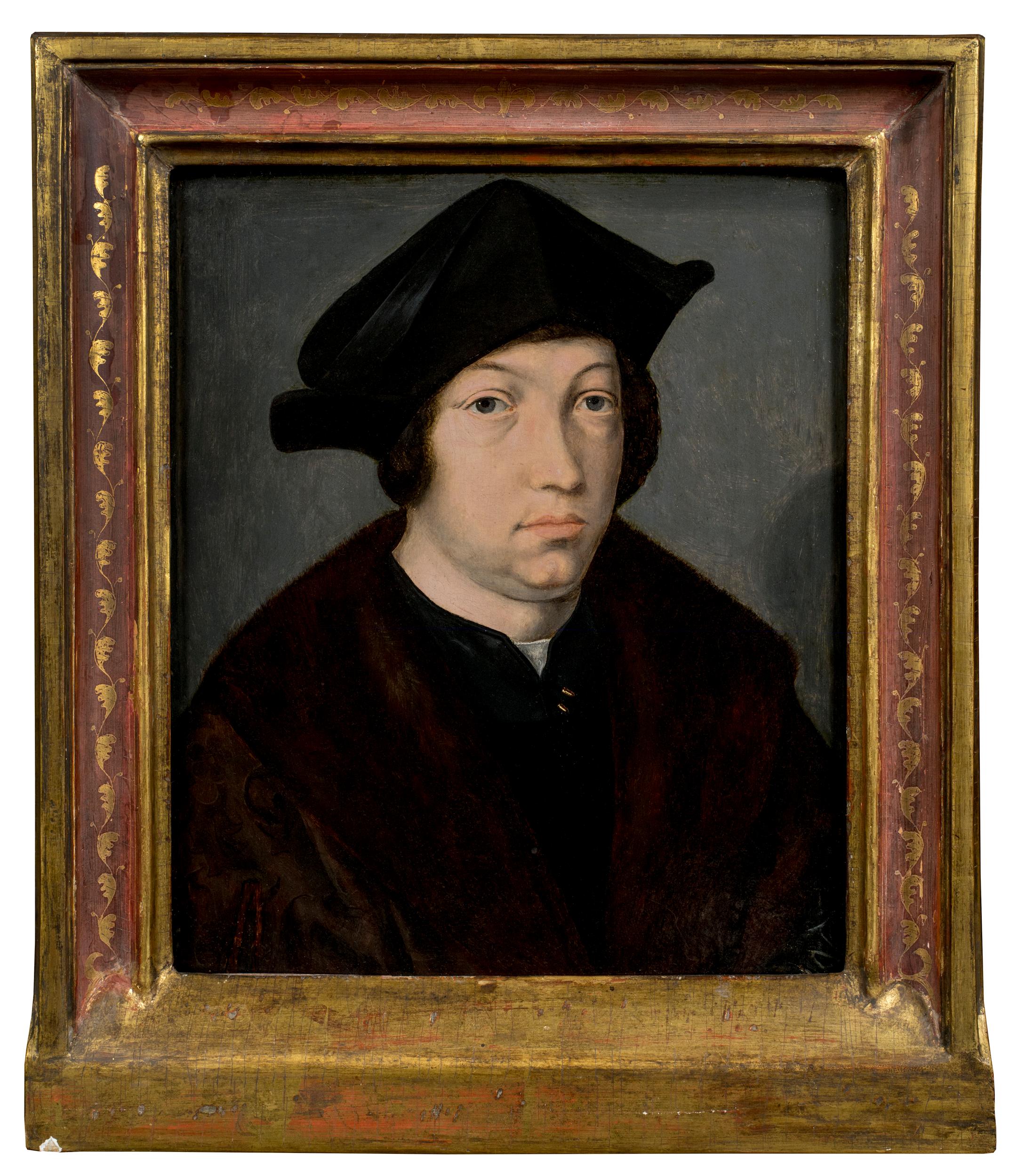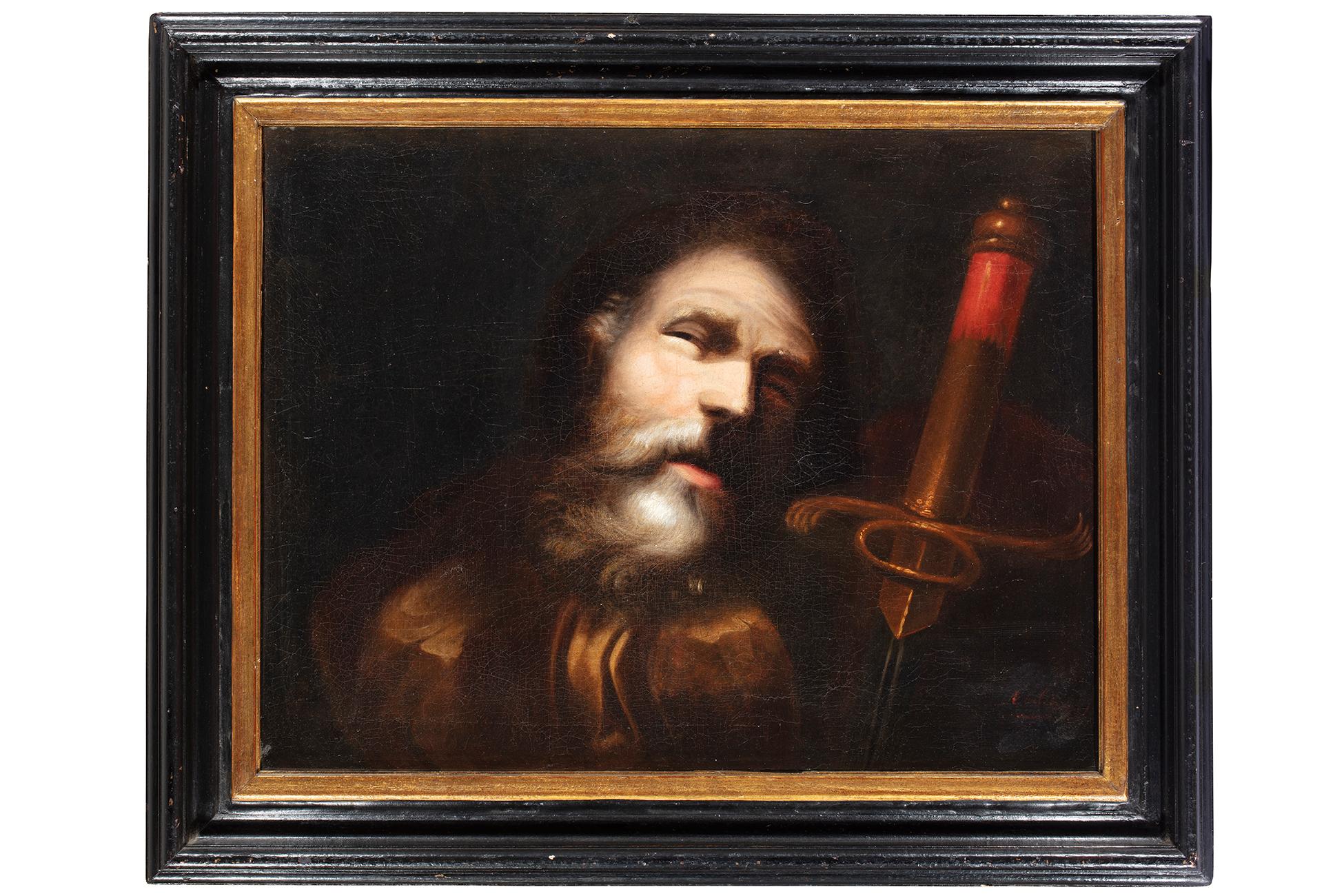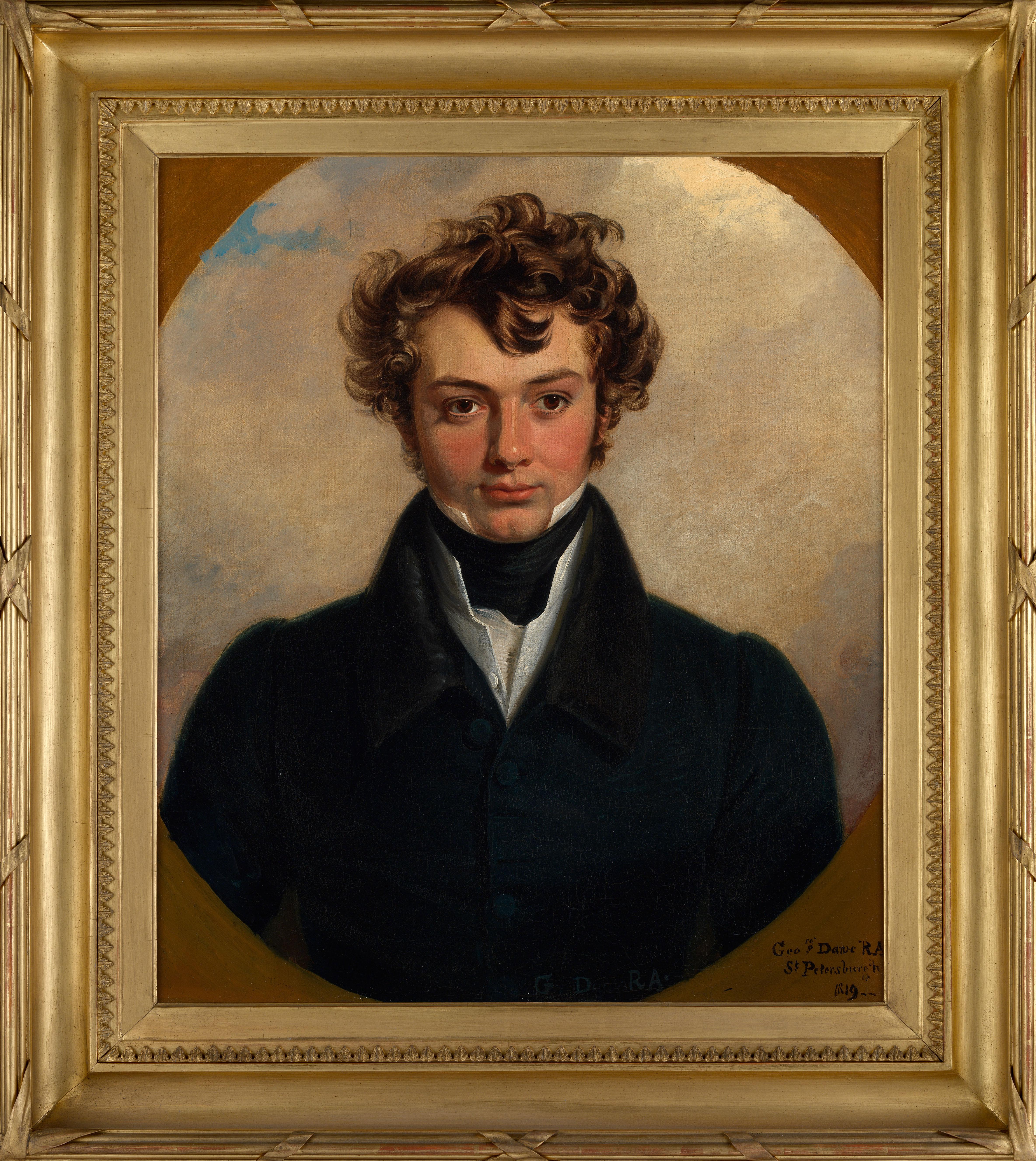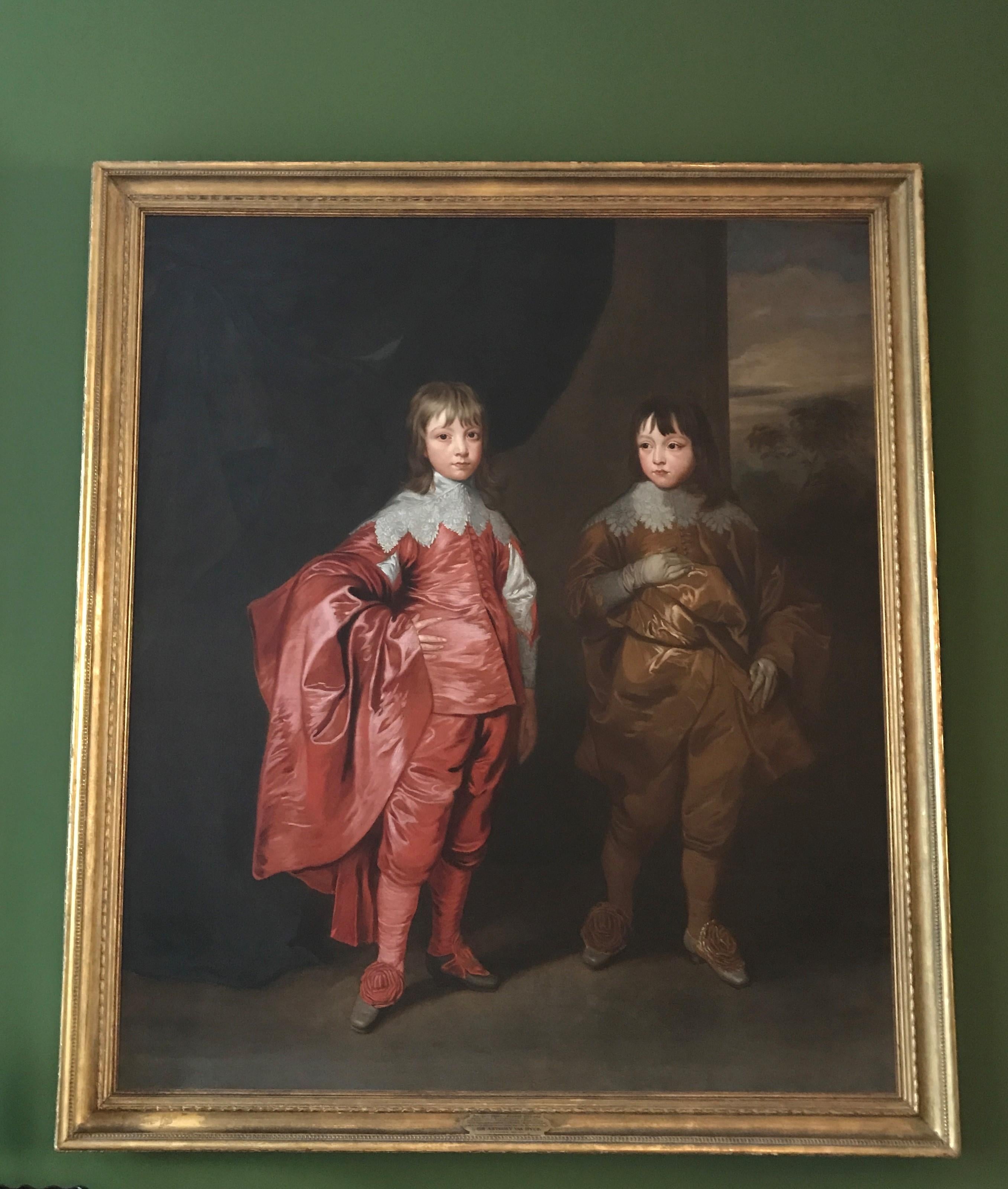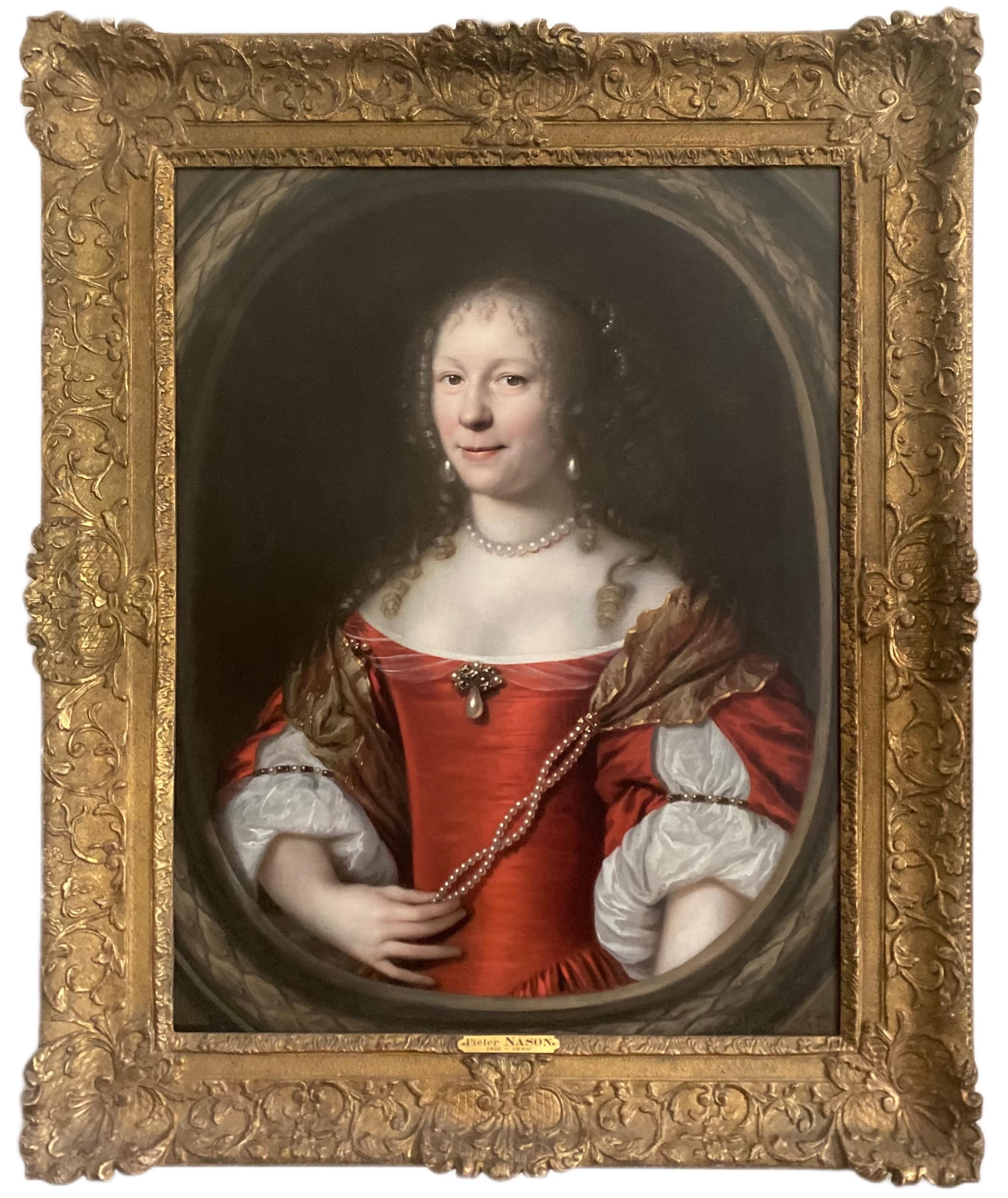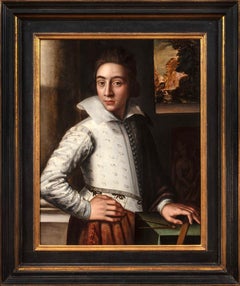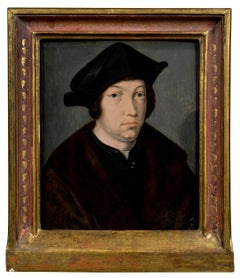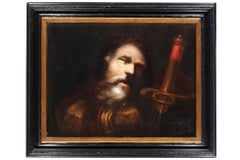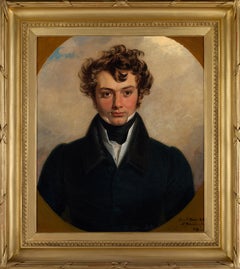Items Similar to Saint Mark Evangelist Guercino Paint Oil on canvas Old master 17th Century Italy
Want more images or videos?
Request additional images or videos from the seller
1 of 17
Saint Mark Evangelist Guercino Paint Oil on canvas Old master 17th Century Italy1670-1720
1670-1720
About the Item
Workshop of Giovanni Francesco Barbieri, known as Il Guercino (Cento, 1591 - Bologna, 1666)
Saint Mark the Evangelist
Oil on canvas - 85 x 71 cm., Framed 100 x 86 cm.
Of great character and excellent quality, this precious painting of the seventeenth century has as its subject Saint Mark the Evangelist, half-length portrait, in profile to the right, intent on tempering the quill. On the dark background you can see, on the right, a bookcase with several volumes, an inkwell and a cartouche, elements that allude to his role and the lion with the open Gospel, attributes of the Saint.
The Evangelist, with the features of a young man with a thick beard and hair, of strong expressive vigor, is dressed in a tunic highlighted by an intense red, covered on the shoulders by a blue cloak.
The iconography has its origins in the series of the four Evangelists created between 1615 and 1623 by Guercino commissioned by Cardinal Alessandro d'Este, brother of Duke Cesare d'Este, then sold in 1746 to Augustus III of Saxony and today to the Gemäldegalerie of Dresden.
Our canvas therefore shows its evident belonging to the narrow sphere of the Emilian master of the seventeenth century: the executive technique and stylistic features agree with those of a work that can still be dated to the first half of the seventeenth century, which manifests the characteristics of an artist of a narrow scope. Guercinesco, well informed about the pictorial novelties conceived by the master, and therefore presumably active in his prestigious workshop.
In our specific case, the independent typological characters correspond to those of Bartolomeo Gennari's painting (Conto, 1594 - Bologna, 1661), a painter constantly active alongside Barbieri.
Over the years of his enduring career Bartolomeo devoted himself steadily to the creation of works and derivations from Guercino's compositions, for this reason he is esteemed as one of the best official copyists of the master, who usually assigned him the replicas of his best inventions, sometimes intervening person to perfect them and make them difficult to distinguish from the paintings of total Guercinesque autograph.
The painting is completed with a beautiful wooden frame.
ADDITIONAL INFORMATION:
The painting is sold with a certificate of authenticity and a descriptive iconographic card.
We take care and organize the transport of the purchased works, both for Italy and abroad, through professional and insured carriers.
Contact us for any information, we will be happy to answer you.
- Creation Year:1670-1720
- Dimensions:Height: 39.38 in (100 cm)Width: 33.86 in (86 cm)
- Medium:
- Movement & Style:
- Circle Of:Giovanni Francesco Barbieri, known as Il Guercino (Cento, 1591 - Bologna, 1666) (1591 - 1666, Italian)
- Period:
- Condition:
- Gallery Location:Riva del Garda, IT
- Reference Number:1stDibs: LU988110123212
About the Seller
4.9
Platinum Seller
Premium sellers with a 4.7+ rating and 24-hour response times
Established in 2017
1stDibs seller since 2018
239 sales on 1stDibs
Typical response time: <1 hour
- ShippingRetrieving quote...Shipping from: Riva del Garda, Italy
- Return Policy
Authenticity Guarantee
In the unlikely event there’s an issue with an item’s authenticity, contact us within 1 year for a full refund. DetailsMoney-Back Guarantee
If your item is not as described, is damaged in transit, or does not arrive, contact us within 7 days for a full refund. Details24-Hour Cancellation
You have a 24-hour grace period in which to reconsider your purchase, with no questions asked.Vetted Professional Sellers
Our world-class sellers must adhere to strict standards for service and quality, maintaining the integrity of our listings.Price-Match Guarantee
If you find that a seller listed the same item for a lower price elsewhere, we’ll match it.Trusted Global Delivery
Our best-in-class carrier network provides specialized shipping options worldwide, including custom delivery.More From This Seller
View AllHudibras Triomphante Hogarth Paint Oil on canvas 18th Century Paint Old master
Located in Riva del Garda, IT
18th century English painter
William Hogarth (London 1697 - 1764) School of
Hudibras Triomphante (from the poem by Samuel Butler)
Circa 1740, England
Oil on canvas (62 x 50 cm. - F...
Category
18th Century Old Masters Paintings
Materials
Oil
$5,838 Sale Price
20% Off
Portrait Woman Parodi 17/18th Century Oil on canvas Old master
By Domenico Parodi (Genoa, 1672 - 1742)
Located in Riva del Garda, IT
Domenico Parodi (Genoa, 1672 - 1742)
Portrait of Anne Marie d'Orléans (Château de Saint-Cloud, 27 August 1669 - Turin, 26 August 1728), first queen consort of Sardinia and maternal g...
Category
18th Century Old Masters Paintings
Materials
Oil
$5,838 Sale Price
20% Off
Mater Dolorosa Madonna Maria Dolci 17/18th Century Paint Oil on table Old master
Located in Riva del Garda, IT
Carlo Dolci (Florence 1616 - 1686)
shop
Mater Dolorosa, known as Our Lady of the Finger
Oil on oval canvas,
29 x 23 cm.
In frame 48 x 43 cm.
The painting we present to you depicts ...
Category
17th Century Old Masters Paintings
Materials
Oil
$4,170 Sale Price
20% Off
Philip V King Spain Louise Savoy Queen Gobert Paint Oil 18th Century Old master
Located in Riva del Garda, IT
Circle of Pierre Gobert (Fontainebleau 1662 - Paris 1744)
Pair of portraits
Portrait of Philip V, King of Spain (Versailles 1683 - Madrid 1746)
Portrait of Queen Louise of Savoy (16...
Category
18th Century Old Masters Paintings
Materials
Oil
$8,102 Sale Price
20% Off
Frederick III Cranach Rohrich Paint Oil on table 19th Century Flemish Portrait
Located in Riva del Garda, IT
Follower of Lucas Cranach I (Kronach, 1472 - Weimar, 1553)
Attributed to Franz Wolfgang Rohrich (Nuremberg 1787 - 1834)
Frederick III of Saxony, called the Wise (1486-1525)
Oil on ...
Category
19th Century Old Masters Portrait Paintings
Materials
Oil
$8,102 Sale Price
20% Off
Ecce Homo Coxie Paint 16/17th Century Paint Oil on table Old master Flemish Art
Located in Riva del Garda, IT
Circle of Michael Coxie (Malines, 1499 - Malines, 1592)
Ecce Homo with Pontius Pilate
Oil on panel
Flemish school 16th-17th century
112 x 81 cm - framed 121 x 90 cm.
The proposed p...
Category
16th Century Old Masters Paintings
Materials
Oil
$8,102 Sale Price
20% Off
You May Also Like
Portrait of an Artist (possibly a Self-Portrait)
Located in New York, NY
Provenance:
Bradley Collection.
Private Collection, Upperville, Virginia.
Literature:
Katlijne van der Stighelen and Hans Vlieghe, Rubens: Portraits of Unidentified and Newly Identified Sitters painted in Antwerp, Corpus Rubenianum Ludwig Burchard, vol. 19, pt. 3, London and Turnhout, 2021, under cat. no. 189, p. 161, and fig. 75.
This painting had previously been considered to be by an anonymous Tuscan painter of the sixteenth century in the orbit of Agnolo Bronzino. While the painting does in fact demonstrate a striking formal and compositional similarity to Bronzino’s portraits—compare the nearly identical pose of Bronzino’s Portrait of a Young Man in the Metropolitan Museum of Art (Fig. 1)—its style is completely foreign to Italian works of the period. That it is painted on an oak panel is further indication of its non-Italian origin.
This portrait can in fact be confidently attributed to the Antwerp artist Huybrecht Beuckelaer. Huybrecht, the brother of Joachim Beuckelaer, has only recently been identified as the author of a distinct body of work formerly grouped under the name of the “Monogrammist HB.” In recent studies by Kreidl, Wolters, and Bruyn his remarkable career has been delineated: from its beginnings with Joachim in the workshop of Pieter Aertsen; to his evident travels to Italy where, it has been suggested, he came into contact with Bronzino’s paintings; to his return to Antwerp, where he seems to have assisted Anthonis Mor in painting costume in portraits; to his independent work in Antwerp (where he entered the Guild of Saint Luke in 1579); and, later to his career in England where, known as “Master Hubberd,” he was patronized by the Earl of Leicester. Our painting was recently published by Dr. Katlijne van der Stighelen and Dr. Hans Vlieghe in a volume of the Corpus Rubenianum, in which they write that the painting “has a very Italian air about it and fits convincingly within [Beuckelaer’s] oeuvre.” Stighelen and Vlieghe compare the painting with Peter Paul Ruben’s early Portrait of a Man, Possibly an Architect or Geographer in the Metropolitan Museum of Art, in which the sitter holds a compass and wears a similarly styled doublet (Fig. 2).
Huybrecht both outlived and travelled further afield than his brother Joachim, who made his career primarily in Antwerp. Whereas Joachim was the main artistic inheritor of their uncle and teacher, Pieter Aertson, working in similar style and format as a specialist in large-scale genre and still-life paintings, Huybrecht clearly specialized as a painter of portraits and was greatly influenced by the foreign artists and works he encountered on his travels. His peripatetic life and his distinctly individual hand undoubtedly contributed to the fact his career and artistic output have only recently been rediscovered and reconstructed. His periods abroad seem to have overlapped with the mature phase of his brother Joachim’s career, who enrolled in the Antwerp Guild of Saint Luke much earlier than his brother, establishing himself as an independent painter in 1560. Joachim’s activity was confined to the following decade and half, and his latest work dates from the last year of his life, 1574. Our portrait was likely produced in the late 1560s, a dating supported by the dendrochronological investigation performed by Dr. Peter Klein, which established that it is painted on an oak panel with an earliest felling date of 1558 and with a fabrication date of ca. 1566.
This painting presents a portrait of an artist, almost certainly Huybrecht’s self-portrait. The young sitter is confidently posed in a striking patterned white doublet with a wide collar and an abundance of buttons. He stands with his right arm akimbo, his exaggerated hands both a trademark of Huybrecht and his brother Joachim’s art, as well as a possible reference to the “hand of the artist.” The figure peers out of the painting, interacting intimately and directly with the viewer, as we witness him posed in an interior, the tools and results of his craft visible nearby. He holds a square or ruler in his left hand, while a drawing compass...
Category
16th Century Old Masters Paintings
Materials
Oil, Panel
Portrait of a Man
Located in New York, NY
Provenance:
with Leo Blumenreich and Julius Böhler, Munich, 1924
Dr. Frederic Goldstein Oppenheimer (1881-1963), San Antonio, Texas; by whom given to:
Abraham M. Adler, New York, until 1985; thence by descent to the present owners
While old inscriptions on the verso of this panel propose its author to be Hans Holbein and the sitter Sir John More—a lawyer, judge, and the father of Sir Thomas More—this fine portrait has long been recognized to be by a Flemish hand. Max Friedländer gave the painting to Bernard van Orley (1487/1491 – 1541) in 1924, but did not include it in the volume dedicated to the artist in his Early Netherlandish Paintings...
Category
16th Century Old Masters Portrait Paintings
Materials
Oil, Panel
$52,500
17th Century by Juan Alfonso Abril Head of St Paul Painting Oil on Canvas
Located in Milano, Lombardia
Juan Alfonso Abril (active in the 17th century in Valladolid, Spain)
Title: Head of Saint Paul
Medium: Oil on canvas
Dimensions: without frame 48.5 x 62 ...
Category
Early 17th Century Old Masters Figurative Paintings
Materials
Canvas, Oil
19th century portrait painted in St Petersburg in 1819
Located in London, GB
Signed, inscribed and dated, lower right:
'Geo Dawe RA St Petersburgh 1819', also signed
with initials, lower centre: 'G D RA'; and signed and inscribed verso:
'Geo Dawe RA Pinxit 1819 St Petersburgh';
Also inscribed on the stretcher by Cornelius Varley with varnishing instructions.
Collections:
Private collection, UK, 2010
Literature:
Galina Andreeva Geniuses of War, Weal and Beauty: George Dawe...
Category
19th Century Old Masters Portrait Paintings
Materials
Oil, Canvas
Double Portrait Oil Painting Brothers George, 2nd Duke Buckingham & Lord Francis
By (After) Anthony Van Dyck
Located in London, GB
Aftrer Anthony VAN DYCK - maybe Studio (1599, Antwerp – 1641, London) Flemish
Double Portrait of George Villiers, 2nd Duke of Buckingham (1628-1687) & Lord Francis Villiers (1629-1648)
Oil on Canvas
170 x 147 cm
Anthony Van Dyck (1599-1641)
No painter has done more to define an era than Anthony van Dyck. He spent only seven and a half years of his short life (1599- 1641) in England. He grew up in Antwerp, where his precocious talent was recognised by Peter Paul Rubens, the greatest painter of his age. He worked in Rubens’s studio and imitated his style as a religious artist, painting biblical scenes redolent of the lush piety of the counter-reformation. But soon he was on the move. In 1620, he visited London for a few months, long enough to paint a history picture, The Continence of Scipio, for the royal favourite, George Villiers, Marquess of Buckingham, and a portrait of his other English patron, the great art collector, Thomas Howard, 2nd Earl of Arundel.
After a stint in Italy, making imposing portraits of the wealthy aristocracy and sketching and copying works by Titian, he returned to the Spanish Netherlands in 1627, becoming court artist to Archduchess Isabella before departing for The Hague in 1631 to paint the Dutch ruler Frederick Henry, Prince of Orange. Charles I’s invitation in 1632 led Van Dyck back to London where he was knighted, paid an annual salary of £200 and installed in a house in Blackfriars with a special jetty at which the royal barge might tie up when the King was visiting his studio. By this time Van Dyck was recognised as the leading court painter in Europe, with Velazquez at the court of Philip IV of Spain his only rival. He also excelled as a superbly observant painter of children and dogs.
Van Dyck’s notoriety in depicting children led to the introduction of groups of children without their parents as a new genre into English painting (amongst other new genres).
For the next 300 years, Van Dyck was the major influence on English portraiture. Nearly all the great 18th Century portraitists, from Pompeo Batoni and Allan Ramsay to Thomas Gainsborough and Joshua Reynolds, copied Van Dyck’s costumes, poses and compositions.
George Duke of Buckingham & his brother Francis Villiers
Painted in 1635, this double portrait was originally commissioned by Charles I, who raised the two brothers after their father, George Villiers, was assassinated in 1628. Together with their sister, Lady Mary Villiers, they enjoyed the King’s favour absolutely. Francis whose absolute ‘inimitable handsomeness’ was noted by Marvell (who was killed in a skirmish near Kingston upon Thames). The young duke who commanded a regiment of horse at the Battle of Worcester, remained closely associated with Charles II, held a number of high offices after the Restoration and was one of the most cynical and brilliant members of the King’s entourage, immortalised as ‘Zimri’ in Dryden’s Absalom and Achitopbel. As a young man he had sold his father’s great collection of pictures in the Spanish Netherlands, many of them to the Archduke Leopold Willhelm.
Painted for Charles I and placed near the portrait of their sister in the Gallery at St James’ Palace. The handling of both costumes is very rich, and the heads are very carefully and sensitively worked. That of the younger boy in particular is more solidly built up than the lower part of the figure. A preparatory drawing for the younger boy is in the British Museum.
There are copies at, e.g., Highclere Castle...
Category
17th Century Old Masters Portrait Paintings
Materials
Oil
17th century Dutch portrait of a Lady in Red adorned with Pearls
By Pieter Nason
Located in Bath, Somerset
Portrait of a lady, half-length in a feigned oval wearing a ruby coloured silk gown holding entwined strings of pearls across her bodice. Signed 'PNason' and dated 1667 (lower right)...
Category
17th Century Old Masters Portrait Paintings
Materials
Oil, Canvas
$26,025 Sale Price
20% Off
Recently Viewed
View AllMore Ways To Browse
Black Framed Antique Oil Paint
Mark Seely
Saint Oil Painting
Old Master Painting Italian
Black Saint Painting
Saint Painting Antique
17th Italian Art
Old Man Oil Painting
Old Antique Dresses
17th Century Old Master Oil Painting
Italy Saint Painting Oil
Italian Old Masters 17th Century
Old Masters Attributed
Lion On Canvas
Replica Italian
Antique Wooden Saints
Replica Paintings
17th Century Saint Paintings
